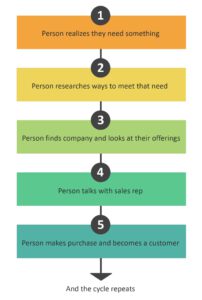Need help implementing your CX goals?
Our industry knowledge and experience are at your service. Contact CX by Design for a free 30-minute session and take the first step towards a thriving future!

edit Lis Hubert
event 09/20/2023
pace 4 mins
This is the first in a two-part series on understanding the customer journey. In the first part, we’ll explain what a customer journey is and why it’s important. In the second part, we’ll walk you through mapping the customer journey.
If you want to provide a great customer experience, you have to understand what customers need – and this changes according to where they are in their customer journey. In this article, we’ll examine each stage of the customer journey. We’ll also talk about what you need to provide at each stage of this journey.
It’s a common misconception that customer journeys work like this:
In fact, the customer journey encompasses all of the touchpoints or interactions a person has with your brand – before, during, and after making a purchase.
Customer journeys are rarely linear, as depicted below:

In real life, things are never that simple. The customer journey often looks more like this:

Because there are so many touchpoints and so many factors involved, analyzing the customer journey is a must if you want to provide an excellent customer experience. Only once you understand what customers are doing, thinking, feeling, and trying to achieve at various points in the journey can you make that journey rewarding.
You may hear all three of these terms, and sometimes they are used interchangeably. What’s the difference?
There are five stages in a customer journey:

At each stage in the customer journey, you have the opportunity to connect with that person in a meaningful way. You can see each stage as a chance to sell your product and trumpet how great you are. Or you can give people relevant and useful information that actually meets their needs. Every interaction is an opportunity to show that you want to connect with that person as a person – not just another anonymous sale.
Why is personal connection so important?
There is a catch: If you don’t understand what’s going on in each stage of the customer journey, you can’t deliver the experience customers want. This can have carryover effects into other business areas, leading human-centric companies to redefine what a customer is.
So, let’s increase our understanding by taking a deeper dive into each stage of the customer journey.

During the awareness phase, your potential customer is thinking about their need or problem. They are collecting facts and analyzing their options.
At this point, your goal is to capture the person’s attention and begin raising interest in your company. You can also position your company as a trusted source of information. As a business, you need to be aware of your customers’ intentions at all times, but nowhere is this more important than in the Awareness phase. The person (who is not yet a customer) doesn’t have the immediate intention of buying; their intention is gathering information. So you must meet that intention by providing high-quality information that’s easy to understand and easy to find. This means building your online presence.
Even businesses that depend on their brick-and-mortar stores need to invest in an online presence; 63% of all shopping trips start online. The Internet is our collective first choice for gathering information – even if we’ll later complete the purchase in a physical store.
For any brand, creating excellent online content and customer experiences is key to building awareness. The content you produce for this phase should be educational, engaging, and not overly salesy. Potential customers usually find this content through search engine results and social media, which will funnel them to your blog and other free resources (explainer videos, whitepapers, guides, etc.).
To engage with potential customers in the Awareness phase, it’s essential to focus on their problems or needs. Instead of creating a blog post titled “5 Reasons to Buy Our Product”, think “5 Reasons Why You’re Having Problem X” or “5 Trendy Gifts for Occasion Y”.

Once customers are confident they understand their need, they’ll start exploring possible solutions. This is the Consideration stage. Customers have moved beyond general information and started evaluating if your service/product will work for them.
Now is the time to emphasize your unique selling points. They may have narrowed their search down to two or three potential purchases. Why should they choose your company? Do you have a lot of specialized experience, an innovative manufacturing process, super-convenient delivery? Find a way to offer something uniquely valuable to that customer.
In this part of the customer experience, you’re building on the trust you’ve already established as a source of information. Your potential customer will probably be getting some details directly from your website; they may also be reaching out to sales reps for personalized attention. Now you can offer solution-oriented content, such as product guides and comparisons, customer testimonials, and so on.
There’s an important caveat here. Once again, you’ll need to recognize the customer intention at this stage of the journey. The Consideration stage is not the Purchase stage; rushing the potential customer at this point can feel pushy. Keep providing them with the information they need to reach a purchasing decision, but don’t turn on the high-pressure sales techniques.

The person has made their decision and started the purchasing process. They’re looking at pricing pages, signing up for free demos and consultations, and talking over details with sales reps. If the transaction is online, make sure your shopping cart and checkout process is straightforward, intuitive, easy to use, and secure. If the purchase will happen in a store, pay attention to how customers move through the store and how they interact with employees.
At this stage, you’ve officially acquired a new customer! However, the customer journey isn’t done; followup care is an important part of turning new customers into repeat customers.

Communication is central to the post-purchase experience. Businesses want to keep their customers informed about upcoming deals and events; they also need to ensure that customers are happy with their purchase.
During this stage, it’s important to use customer data responsibly and offer several contact options (social media, chatbots, phone, email, push notifications, etc.). How can you accommodate customer intent during this stage? Allowing the customer to choose what they want to see and when they see it will make the post-purchase experience feel more personal. It will also build a sense of trust with the brand, as customers are less likely to feel messaging is intrusive when they can customize it to their preferences.
Handling customer complaints also comes under the umbrella of encouraging satisfaction and retention. Offering several channels to address complaints and giving employees the right training can turn a negative customer experience into a positive one.

Satisfied customers can’t help but talk about the good experience they’ve had with your brand. If you keep delighting them, they’ll keep coming back – and encouraging others to try your solutions as well.
Congratulations! You’ve acquired a brand advocate – someone who is so thrilled about your customer experience that they’re recommending your company to others. Don’t take brand advocates for granted, and don’t leave them to chance. You can encourage brand advocacy by building it into your loyalty program or offering incentives for social media mentions and in-person recommendations. But the biggest thing you can do to encourage brand loyalty and advocacy is to continue providing a great customer experience.
How do you do that? Once again, it’s all about giving your customers what they need for that stage of their journey. And to understand that, you need to understand their entire journey. We’re back to the customer journey map.
A customer journey map describes what customers do, think, feel, and want at various points in the customer journey. In the second part of this series, we’ll give you a step-by-step explanation of how to create your own customer journey map.
Our industry knowledge and experience are at your service. Contact CX by Design for a free 30-minute session and take the first step towards a thriving future!

Want to help your company thrive using the principles of human-centered design? Our FREE 30-minute introductory session will get you on the right path!
Schedule your free consultation